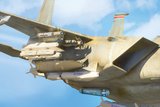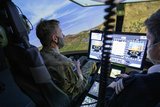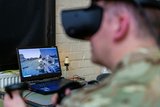Triton – the future of maritime domain awareness
Brought to you in partnership with Northrop Grumman
When the Global Hawk unmanned aircraft took to the sky for the first time on a calm California morning in 1998, the gathered crowd were not aware they were witnessing the future of maritime surveillance.
Sporting a unicorn-like nose and US Air Force markings, the ungainly-looking machine carried out a 56-minute first flight that has since become a key milestone in the origin story of today’s MQ-4C Triton.
‘Triton’s on-station time and range enables unmatched awareness of the maritime battlespace by sustaining the common operational tactical picture (COTP) for surface warfare and the Overseas Contingency Operation,’ according to the US Navy.
The MQ-4C Triton programme of record took a further step forward in May 2019 when manufacturer Northrop Grumman was awarded a contract for the delivery of long-lead items for the production of three LRIP Lot 5 Tritons for Australia and the US.
The programme of record ultimately calls for Northrop Grumman to deliver 68 aircraft to the US Navy while Australia plans to buy six.
‘With the Triton’s large wingspan, it’s able to stay aloft for 24 hours, above 50,000 feet. The sensor suite has the ability to detect, track and identify targets of interest,’ Doug Shaffer, Vice President and Programme Manager for the MQ-4C at Northrop Grumman, explained to Studio.
‘It starts with electronic support measures, the ESM system for electronic detection of ships. It has automatic identification systems, AIS, to understand who the actual ship is. It has a Multi-Function Active Sensor radar to detect at long ranges.
‘You pull that data together to understand what the intent of that vessel in the ocean is. And then to get positive identification, we have the [MTS-B] electro-optical infrared sensor to actually put eyes on target. That information goes to a ground station where the navy disseminates that information to different parts of the globe for the commanders to make decisions.’
The MQ-4C Triton has had multiple enhancements to optimise the platform for the maritime surveillance role, including reinforcements to the fuselage and wing, de-icing systems and lightning protection, allowing it to descend and ascend through cloud layers to get a better look at targets of interest.
The platform also features a new sensor in the form of the AN/ZPY-3 Multi-Function Active Sensor (MFAS). A 360-degree field-of-regard active electronically scanned array radar designed for maritime surveillance, the MFAS uses a combination of electronic scanning and mechanical rotation, allowing it to spotlight a geographic area of interest for longer periods to increase detection capabilities of smaller targets, particularly in sea clutter.
Triton’s full sensor suite allows areas up to 2,000 square miles to be monitored at a time.
One key feature of the MQ-4C is its ability to team with the P-8A Poseidon multi-role maritime patrol aircraft, with the ultimate aim of P-8A crews being able to operate the sensor of a Triton on operations.
The Royal Australian Air Force (RAAF) is looking at such a teaming concept when it begins operating its first MQ-4C in around 2023.
Air Cdre Craig Heap, commander of the RAAF’s Surveillance and Response Group, told Shephard earlier in 2019 that the Triton and P-8A were part of a wide area surveillance family of systems, which were conducting similar roles but each optimised in a different area.
‘The Triton is certainly optimised for long-range, persistent reach, with tremendous fidelity in its sensors to enable it to locate assets, to locate contacts at extreme range; and then inform a response, which is really the P-8’s role – to respond to whatever the Triton can find,’ Heap explained.
He noted that as well as the traditional warfighting roles of ASW and ASuW, the platform was suitable for humanitarian assistance, disaster relief, search and rescue, and general maritime and overland ISR collection.
‘One of the key things is that the Triton will be a tremendous asset in the initial response for humanitarian assistance and disaster relief, and also in a search and rescue scenario, given its range, and the fact it – along with that multi mission, manned/unmanned teaming concept – can guide a bunch of manned assets in with a response to certain situations.’
Shaffer highlighted the fact that with the Global Hawk used around the world by the US Air Force since 2001, amassing more than 250,000 flight hours, a smooth path was paved for the Triton programme.
‘That lineage allowed us to develop the most sophisticated air platform to meet the Pentagon’s requirements around the globe,’ he outlined.
‘As a high-altitude platform optimised for the maritime surveillance role, Triton provides and enables the surveillance of huge swaths of the globe. You think about how vast our oceans are – finding out the intent of every vessel on those oceans, you need a platform like this. At the end of the day, this is about providing near-real-time data to mission commanders around the globe to help them in their decision-making process in the battlefield.’
More from Studio
-
![Combat-proven capabilities: How precision-strike systems are evolving for tomorrow’s battlespace (podcast)]()
Combat-proven capabilities: How precision-strike systems are evolving for tomorrow’s battlespace (podcast)
Combat-tested technology is being reshaped to counter A2/AD threats, reduce reliance on GPS and enable faster, more autonomous targeting in complex environments. In this special podcast, experts explain how the evolving threat landscape is shaping next-generation strike capabilities.
-
![Energy evolution: How laser defence systems are powering the next phase of air defence (podcast)]()
Energy evolution: How laser defence systems are powering the next phase of air defence (podcast)
Laser-based air defence is moving from promise to deployment as global threats evolve. In this special podcast, we explore how high-energy laser systems are reshaping interception strategies.
-
![Intelligence advantage: How real-time GEOINT is reshaping military decision-making (Studio)]()
Intelligence advantage: How real-time GEOINT is reshaping military decision-making (Studio)
In today’s contested operational environment, adaptability is key. The new Geospatial-Intelligence as a Service (GEO IaaS) solution from Fujitsu and MAIAR empowers militaries by enabling intelligence advantage, combining advanced technology with human expertise to deliver actionable insights.
-
![Training Together: Unlocking Educational Excellence through Military and Industry Collaboration (Studio)]()
Training Together: Unlocking Educational Excellence through Military and Industry Collaboration (Studio)
Military training is ultimately about people. At Capita, training programmes are built on close engagement with partners, delivering an educational approach that can adapt to individual needs, cultivate leadership – and drive wider cultural change.
-
![Enhancing Military Training Through Digital Technology (Studio)]()
Enhancing Military Training Through Digital Technology (Studio)
Digital technologies offer huge opportunities for defence training. However, militaries must adopt an agile approach, placing the needs of their organisations and personnel at the centre of their efforts.
-
![Layered Defence: How new technologies are enhancing armoured vehicle survivability and manoeuvrability (Studio)]()
Layered Defence: How new technologies are enhancing armoured vehicle survivability and manoeuvrability (Studio)
As modern threats evolve, armoured fighting vehicles face a new era of challenges, from loitering munitions to kinetic energy projectiles. Advances in active, passive, and reactive protection systems are crucial to ensuring battlefield dominance, freedom of manouver and vehicle survivability.

























